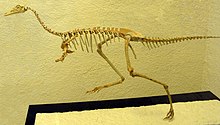Alvarezsauroidea
| Alvarezsaurs Temporal range: Late Jurassic-Late Cretaceous, 160–66 Ma |
|
|---|---|
 |
|
| Reconstructed skeleton of a Mononykus olecranus | |
| Scientific classification | |
| Kingdom: | Animalia |
| Phylum: | Chordata |
| Class: | Reptilia |
| Clade: | Dinosauria |
| Order: | Saurischia |
| Suborder: | Theropoda |
| Clade: | Maniraptora |
| Clade: |
†Alvarezsauria Bonaparte, 1991 |
| Superfamily: |
†Alvarezsauroidea Bonaparte, 1991 |
| Type species | |
|
Alvarezsaurus calvoi Bonaparte, 1991 |
|
| Subgroups | |
†Alnashetri
†Haplocheirus
†Alvarezsauridae
Alvarezsauroidea is a group of small maniraptoran dinosaurs. Alvarezsauroidea, Alvarezsauridae, and Alvarezsauria are named for the historian Don Gregorio Alvarez, not the more familiar physicist Luis Alvarez, who proposed that the Cretaceous–Paleogene extinction event was caused by an impact event. The group was first formally proposed by Choiniere and colleagues in 2010, to contain the family Alvarezsauridae and non-alvarezsaurid alvarezsauroids, such as Haplocheirus, which is the basalmost of the Alvarezsauroidea (from the Late Jurassic, Asia). The discovery of Haplocheirus extended the stratigraphic evidence for the group Alvarezsauroidea about 63 million years further in the past. The division of Alvarezsauroidea into the Alvarezsauridae and the non-alvarezsaurid alvarezsauroids is based on differences in their morphology, especially in their hand morphology.
The first fossil alvarezsauroids were recognized in the 1990s. Since then, the number of specimen found has dramatically increased. Most of the recent alvarezsauroids are found in China. But they are also known from North- and South-America, as well as Europe. They existed from the Late Jurassic to the Late Cretaceous. The basalmost and oldest alvarezsauroid of the Chinese alvarezsaurs is from the Shishugou Formation in Xinjiang (earliest Late Jurassic). Additionally, two derived members of the derived alvarezsaur group Parvicursorinae are known from the Inner Mongolia and Henan (Late Cretaceous). The size of the derived members of Alvarezsauroidea range between 0,5 m and 2 m (20 – 80 inches), but some members may have been larger.Haplocheirus, for example, was the largest member of the Alvarezsauroidea. Because of the size of Haplocheirus and its basal phylogenetic position, a pattern of miniaturization for the Alvarezsauroidea is suggested. Miniaturizations are very rare in dinosaurs, but convergently evolved in Paraves.
...
Wikipedia
